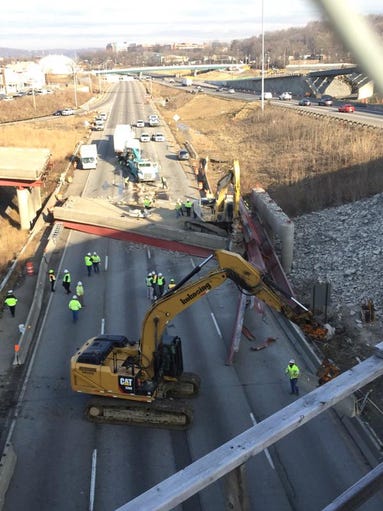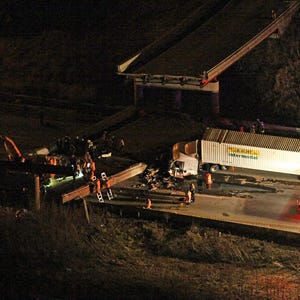

Video from the Ohio Department of Transportation showing the collapse of the I-75 bridge that killed worker Brandon Carl.
The collapse of the closed Hopple Street overpass onto Interstate 75 appeared to be a major construction accident and not a failure of the bridge itself, construction and engineering experts told The Enquirer on Tuesday.
It killed a construction worker late Monday night and paralyzed traffic throughout the region, also crushing the front of a tractor-trailer truck underneath; the driver only sustained minor injuries. The incident occurred at 10:30 p.m., about a half an hour before demolition was set to commence on the span; the highway reopened around 10 p.m. Tuesday.
Experts said the demolition process could have triggered the accident. The Hopple Street interchange project is part of $2 billion overhaul of I-75, and contractors had earlier removed the eastern portion of the bridge that collapsed Monday.

"They should've been demolishing the middle first, and then they would've been OK," said Linwood Howell, a senior engineer for Austin, Texas-based XRStructural Engineering Services, which routinely inspects bridges for the state of Texas.
Contractor Kokosing Construction Company, Inc. was under a $91 million contract to rebuild the Hopple interchange as part of the remaking of that stretch of I-75. That included removing the old ramps and documents obtained by The Enquirer on Tuesday indicate that the company faces penalties of $3,000 for every 15 minutes a lane of I-75 was closed during the project.
"I can see the contractor's point of view in trying to be efficient and saving time and money, thinking 'I've got to close traffic down in order to work on the middle so let me just go ahead and take the sides out first,' " Howell said. But taking the sides off first is "the worst thing to be doing on a bridge like this."
By taking down a side portion of the bridge, it weakened the overall structure, How
University of Cincinnati architecture professor Tom Bible said the pictures indicate a failure of the joints at the western joint of the span. That wouldn't have happened, he said, if the eastern end of the bridge over the median and connecting to the old Hopple Street connection hadn't been previously removed.
"Judging from the pictures, it obviously slipped off its supports," he said.
Westerville-based Kokosing declined to comment on possible explanations for the collapse.
The overpass, which had been shut down weeks ago, had its eastern part previously removed as part of reconstruction of all of I-75 from the Ohio River through Hamilton County to I-275. The new Hopple Street bridge opened for all traffic late last month.
An estimated 200,000 vehicles pass through that section of the highway daily, according to Cincinnati police. But I-75 also is a major commercial route nationally; an estimated $400 billion annually in goods crosses the Brent Spence Bridge – which carries I-75 over the Ohio River – a number equivalent to nearly 4 percent of the nation's gross domestic product.
"What appears to have happened is, in essence, an industrial incident – a workplace incident with respect to a construction crew that's doing work out here," Cincinnati city manager Harry Black said. "Something went wrong, and a tragedy has occurred as a result."
ODOT, the Occupational Safety and Health Administration and Kokosing all began separate investigations into the incident Tuesday morning.
Kokosing a major player in regional highway projects
The incident occurred as Brandon Carl was driving an excavator on top of the old span and moving old steel beams to the east side so the demolition could start. When the bridge collapsed, the beams crushed Carl inside the cab.
The collapse nearly crushed the tractor trailer about to pass under the bridge. The driver, identified as Eric Meyers of Howell, Mich., was hospitalized for minor injuries.
Kokosing officials confirmed that Carl was working for the company and not a subcontractor. The company also confirmed it was performing its own "forensic" investigation into the collapse to figure out why it happened. But Kokosing declined comment on what might have caused the collapse or whether any joints failed or had been loosened in advance of any demolition.
Kokosing is well-known throughout Ohio and according to its website, the company is ODOT's largest highway contractor (it does similar work in West Virginia). Created 60 years ago, Kokosing has more than 35 years of experience in heavy highway construction.
Kokosing has been involved in many local high-profile projects, including several in the area. It built the $50 million Cross County Highway project now known as Ronald Reagan Highway. At the time it was built, the Ronald Reagan Highway was the largest construction project done for ODOT, Kokosing's website notes. It regularly does large projects and other works for ODOT. Kokosing also is involved in the Martin Luther King Jr. interchange near I-71.
In 1992, it purchased the assets of McGraw Construction in Middletown to form a member company called McGraw/Kokosing, Inc. to provide heavy industrial maintenance. That company was involved in the 1994 AK Steel incident in Middletown that resulted in the death of four workers – David Kort of West Price Hill; James Prater Jr., of Middletown; Lonnie J. Stephens Jr., of Bellevue, Ky.; and David Reekers of Ludlow, Ky.
Kokosing has been involved in much of the reconstruction of I-75 in Hamilton County to prepare for the new interstate bridge to cross the Ohio River into Kentucky.
The Enquirer requested Kokosing's worker safety records Tuesday from OSHA, but that data was not immediately available.
There was a similar instance of a bridge collapsing during demolition last May in California; a construction worker died in that accident as well. A section of a weakened bridge in Riverside collapsed while under demolition, while a worker was tethered to it.
"But overall, such collapses are incredibly rare," said Howell.
Bridge safe pre-demolition; construction work dangerous
The bridge that collapsed was originally built in 1961, but got decent reviews in its most recent inspection in 2013. It's "sufficiency rating," or measure of safety, design and structural measures, was 74.7 – anything below a 50 is considered problematic. ODOT released the report of the inspection done in November 2014 late Tuesday, and the overall rating on the span was a 7 on a scale of 1-to-9. That was before demolition work took place, however.
By comparison, the Western Hill Viaduct's sufficiency rating is 36 and the Brent Spence Bridge received a rating of 66.
This was also the first high-profile highway construction worker death in the area since 2006. Previously, however, nine such highway workers died in the region between 2000-2005. Since then, many construction companies have replaced orange barrels with concrete barricades to increase safety.
Overall, private construction remains one of the most dangerous jobs in the nation, according to the Labor Department. The 796 fatal work injuries in construction in 2013 accounted for the highest number of fatal work injuries of any industry sector in 2013.
Kimball Perry, Sharon Coolidge, Jessica Frank and Henry Molski contributed.
Highway construction accidents in Ohio
In Ohio, 4,373 crashes occurred in work zones in 2013, including 1,118 injury crashes and 19 fatalities, according to ODOT.
From 2008 through 2012, ODOT vehicles and equipment were struck 590 times by passing vehicles. Of those, 359 had failed to move over.
http://www.cincinnati.com/story/news/2015/01/20/experts-bridge-collapsed/22070729/



No comments:
Post a Comment